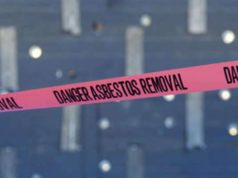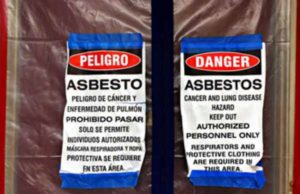
What is Asbestos?
Due to advances in research taken place during the close of the 20th century, asbestos has been identified as an extremely dangerous substance with regard to human exposure. Once used for a majority of fireproofing resulting from chemical properties allowing to it be highly-flame resistant, the biological drawbacks of asbestos exposure have proven to be catastrophic in lieu of its once-assumed provision of safety. Over time – subsequent to its installation and crystallization – asbestos deconstructs and crystalizes into smaller particles, eventually being reduced to microscopic in size.
The Dangers of Asbestos Exposure
Asbestos particles never completely dissolve; they continue to simply reduce in size. Upon examination of asbestos particles, one can observe their uncanny resemblance to sharp, spear-shaped fragments. Once lodged within the human respiratory system through inhalation resulting in long or short-term asbestos exposure, they begin to destroy the lining of the lungs and abdominal cavity. As the asbestos particles become airborne due to their reduction in size, they are easily inhalable. Their respective chemical makeup mirrors the makeup up oxygen particulates.
Upon asbestos exposure, manifesting through the inhalation and ingestion by a human being, the asbestos particulates do not dissolve in the human body. Instead, they remain intact in tandem with the havoc that they wreak on the human respiratory system.
From a medical standpoint, diseases and disorders resulting from asbestos exposure are extremely difficult to treat. The fibrous nature of the asbestos particulates working in concert with their resilience makes their removal from the human body the only preventative measure in curing potential and existing diseases resulting from asbestos exposure. However, due to their microscopic size, complete detection and removal is difficult. Contact asbestos lawyers for legal advice and assistance.
Diseases Resulting from Asbestos Exposure
The two primary diseases that develop subsequent to asbestos exposure are known as mesothelioma and asbestosis:
Mesothelioma
Mesothelioma is a type of cancer that develops and infects the mesothelium, the membrane and lining of organs located within the abdominal cavity. The anatomical purpose of the mesothelium is to provide protection for the lungs and other areas within the abdominal cavity.
Since asbestos particles are both resilient and quick in their breakdown, they are known to spread very rapidly, as does the progress of Mesothelioma. Mesothelioma takes place in the lungs in the majority of cases, due to the fact that asbestos is most often ingested through inhalation. Mesothelioma has lowest survival rate of all known types of cancer.
Asbestosis
Asbestosis is a disease of the lungs resulting from asbestos exposure, which is considered to be progressive in nature. Currently, there exists no known cure for it. Symptoms of Asbestosis can range from shortness of breath, sever cough, fluid in lungs, and flu-like symptoms. Subsequent to the development of the disease, many patients require oxygen treatment or other types of breathing-assistance equipment.
Asbestos Exposure Legal Assistance
The procedures and legislation implicit in the process of investigation of asbestos exposure can fluctuate on an individual, case-by-case basis. Elements examined in the determination of the validity and legality of an asbestos exposure claim exist in conjunction with preexisting factors, which include the constructional integrity of the building in question, the nature of the asbestos exposure, investigative reports, and a description of the correlation between asbestos exposure and the onset of disease.
In the event that an individual experiences difficulties or failure to fully understand stipulations set forth in documentation with regard to the process of investigating asbestos exposure, they are encouraged to consult with an attorney specializing in the field of asbestos law, mesothelioma law, personal injury law, and recovery.





























